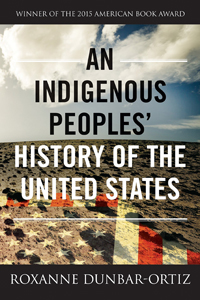 Roxanne Dunbar-Ortiz, An Indigenous Peoples' History of the United States (Boston: Beacon Press, 2014), 296pp.
Roxanne Dunbar-Ortiz, An Indigenous Peoples' History of the United States (Boston: Beacon Press, 2014), 296pp.
If the title of this book sounds familiar, that's because it's a clever play on the best selling book by the radical historian Howard Zinn called A Peoples' History of the United States (1980). In that book, Zinn explored a simple question: Who gets to write history, and in doing so shape the origin stories, myths and narratives by which we live? Most history is written "from above," that is, about presidents, generals, their wars, peace treaties, and the like. Zinn flipped this perspective upside down. He read American history from "below," from the perspective of a coal miner, a black slave, or a factory worker. Indeed, in her Acknowledgements, Dunbar-Ortiz "thanks and honors the memory of Howard Zinn." (239).
Today there are 574 federally recognized tribes that live within the United States, many of them on 310 federal reservations. Their history dates back some 15,000 years. Like Zinn, Dunbar-Ortiz tries to tell their history from their own perspective. It's a radical reversal of the common national narrative of what she variously calls the Columbus myth, the Doctrine of Discovery, and the exceptionalism of a Manifest Destiny. In her telling, this is a story of genocide: "the very existence of the country is a result of the looting of an entire continent and its resources." And what was exterminated was not only the indigenous peoples; their very history was "written out of existence."
Consider just one example, which is explored at length in the book by Claudio Saunt, Unworthy Republic; The Dispossession of Native Americans and the Road to Indian Territory (2020), which won a National Book Award. Nine months after Andrew Jackson was inaugurated as president, in his first message to Congress in December 1829, he called for the "voluntary" emigration of 80,000 Native Americans to lands west of the Mississippi River. Jackson's signature policy of "Indian Removal" was one of the most shameful episodes in American history. In 1841, John Quincy Adams described this decade-long tragedy in his diary as a "sickening mass of putrefaction… It is among the heinous sins of this nation, for which I believe God will one day bring them to judgment."
Indian emigration was not voluntary by any stretch of the imagination, nor was it humanitarian. Rather, it was a state-sponsored mass deportation of "unimaginable violence." It was a land grab by wealthy planters. It was a time of broken treaties and cynical promises, forced marches, racial subjugation in the name of white supremacy, a type of ethnic cleansing, and perhaps a form of genocide. People died from disease (cholera, measles, malaria), exposure, starvation, and "exterminatory warfare." Having stolen Indian lands, the planter-politicians then maximized their profits through "all the woes and horrors" of black slave labor. As the 1830's unfolded, so-called emigration morphed into expulsion, and expulsion into extermination. The "Indian Question," as Saunt shows, was America's counterpart to Europe's "Jewish Question."
Dunbar-Ortiz's version of this history has become a sort of standard if simplistic and even ideological historical revision. You will not learn about Mesoamerican child sacrifice and cannibalism from her. In more recent years scholars have made further and more nuanced revisions, most notably in the burgeoning literature of single-nation studies. I'm thinking in particular of the two volumes by Charles Mann (1491 and 1493), and the two remarkable studies by the Finnish historian Pekka Hämäläinen, The Comanche Empire (Yale, 2008) and Lakota America: A New History of Indigenous Power (Yale, 2019).
In what one scholar called the "cameo theory of history," American indigenous peoples are a sort of blip on the graph of history: they "make dramatic entrances, stay briefly on the stage, and then fade out as the main saga of European expansion resumes." In 1491, Mann describes this popular, powerful, and misleading stereotype, that Columbus discovered a sort of timeless and unspoiled Eden, and a people who lived, as it were, outside of history. In this view, the Indians "were suspended in time, touching nothing and untouched themselves, like ghostly presences on the landscape." Like Mann, Hämäläinen rejects the various caricatures of American Indians — that they lacked agency, that they were barbaric savages of a primitive and pathological violence, "tragic victims" of European colonialism, or "bit players" on the stage of history. Far from it. He shows how at least some tribes were powerful empires in their own right.
So, without doubt, whether by disease or by state-sponsored violence, there was an extermination of indigenous peoples and their history. But to state it so polemically, as Dunbar-Ortiz does, ironically results in a sort of paternalistic perspective toward the people she intends to affirm.
Dan Clendenin: dan@journeywithjesus.net


